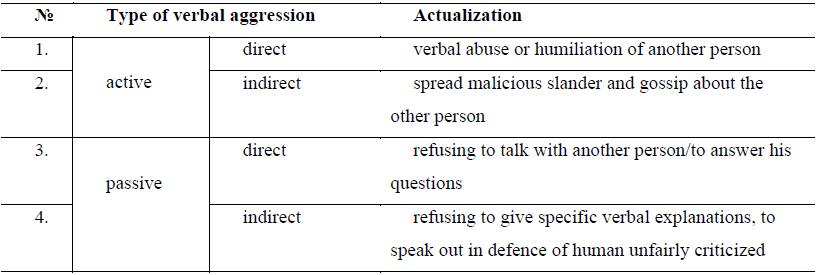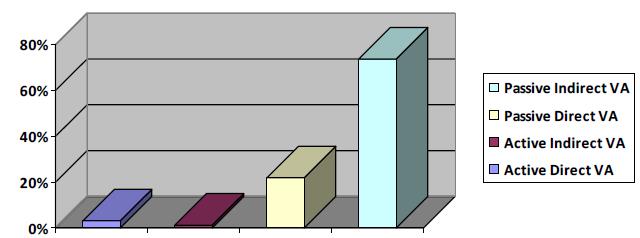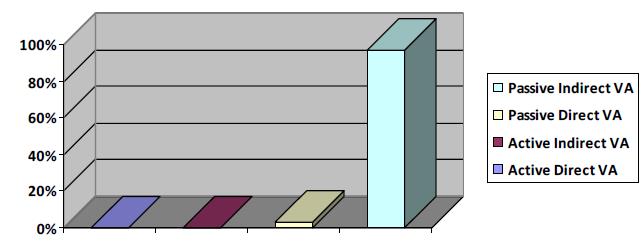Reducing Verbal Aggression Level among Students by Implementation of Pedagogical Cooperation in the Process of Teaching a Foreign Language (Kazan Federal University case study)
Abstract
Discursive practices among students aim at strengthening hostility and becoming more aggressive. Aggressiveness in all its diversity is used as an instrument of the negative impact and for the weakening the partner in communication. The phenomenon of verbal aggression is implemented in a wide range of linguistic resources and discursive practices. The problem of this study is that the first-year students are poorly adapted to studying at the university level, have a different level of both the education and training and as a consequence, their deviant behavior is noticed. The aim of this study is to reduce the level of verbal aggression among students. The study is based on ascertaining method. The study was conducted among teachers and students, Institute of Management, Economics and Finance, Kazan (Volga region) Federal University. The results showed that, depending on the situation and objectives of the sender, students used active (direct/indirect) or passive (direct/indirect) verbal aggression. Recommendations: we consider that The obtained data allow the drawing of a conclusion that in order to neutralize verbal aggression we should base on the principles of pedagogical cooperation, strengthen individual approach to students, strengthen the training of linguistic and cultural studies component, which allows the acquaintance of the students with the best customs and traditions of the target language countries, introduce a regional component of training (Tatarstan, Kazan), involve students to extracurricular work in a foreign language, such as roundtables, presentations and discussions in English and participation in various contests, quizzes, and holidays, such as Christmas Carols.
Keywords: Active verbal aggression, passive verbal aggression, multiculturalism, deviant behavior
Introduction
The system of values of the younger generation has shown significant changes; as a result young
people tend to cynicism, pragmatism and indifference. Discursive practices among students aim to
strengthen hostility and becoming more aggressive. Aggressiveness in all its diversity is used as an
instrument of the negative impact and for the weakening the partner in communication. The dynamics
of social interaction allow speakers to resort to a variety of linguistic strategies which promote,
maintain, or attack an addressee’s face, i.e. ‘‘the positive social value a person effectively claims for
himself [sic]’’ (Goffman, 1967; cf. Brown and Levinson, 1987). Currently the importance of the study
of verbal aggression among students is high due to the fact that it is perceived by students as an
acceptable norm in certain situations and it often finds public justification and approval. Apart from
social norms of behavior, interlocutors’ expectations and interactional goals also influence speakers’
judgments about whether a verbal strategy is impolite, rude or something else (Limberg, 2009).The
phenomenon of verbal aggression, based on the negative emotional and evaluative attitude towards the
partner (-s) and / or the object of communication, is implemented in a wide range of linguistic
resources and discursive practices.
The problem of this study is that the first-year students are not sufficiently socialized into the system
of higher education. They are poorly adapted to studying at the university level, have a different level
of both the education and training and as a consequence, their deviant behavior is noticed. This is the
main reason for the aggressive behavior of students, deterioration of the microclimate in the group and
decrease in students' academic success.
The aim of this study is to reduce the level of verbal aggression among students by implementation
of pedagogical cooperation in the process of teaching a foreign language.
In accordance with the goal, we had the following objectives: to carry out a theoretical analysis of
the concept of verbal aggression; to determine the form of verbal aggression used by students; to
identify the features of the manifestation of verbal aggression among students in the process of learning
a foreign language, to develop recommendations on how to neutralize manifestation of verbal
aggression.
Theoretical background
E. Guetzloe, M. Greene and I. Kalman investigations appear that the problem of verbal aggression is
very acute among young people. Therefore, its comprehensive study is a prerequisite for ensuring the
communicative safety of an individual and society as a whole.
Currently, a number of researchers have suggested a lot of definitions of verbal aggression. Verbal
aggression is message behavior which attacks a person's self-concept in order to deliver psychological
pain (Infante, 1995). Infante and Wigley defined verbal aggressiveness as "a personality trait that
predisposes persons to attack the self-concepts of other people instead of, or in addition to, their
positions on topics of communication (Infante et al., 1986). Verbal aggression can be defined as
deliberately harmful behavior that is typically both unprovoked and repeated. It is an intentional abuse
of power, such as teasing, taunting, or threatening, that is initiated by one or more individuals of
relatively greater status or power (by virtue of their numbers or size) against a victim of somewhat
lesser status or power (Reitman et.al., 2004). The locus of attack is a distinguishing factor in the
variable of verbal aggressiveness as it involves attacking the self-concepts of others rather than their
position on an issue (Infante et.al., 1996).
Methodology
The study is based on ascertaining method (the participant observation method, oral questioning of
students).
Pedagogical cooperation is a system of methods and techniques of education and training based on
the principles of humanism and creative approach to personal development. During training the teacher
should be based on the individual characteristics of the student. Therefore, as a model for verbal
aggression neutralization the following were activated: personal approach as one of the possible
implementations of pedagogical cooperation; strengthening the training of linguistic and cultural
studies component (ensuring the communicative competence in intercultural communication acts),
students should not only listen to the teacher, they should be actively involved in the educational
process; the introduction of a regional component of training (the information about the republic of
residence should be involved in the content of the texts, which allows introducing students to the best
customs and traditions of the target language countries and the country (republic), where they get
higher education.
Modern information and educational technologies allow us to teach a foreign language by
individually-oriented way through: the creation of advanced information in individually-oriented
subject environment, with a variety of educational and information resources and learning
technologies; development and application of multi-level system of individual exercises; organization
of project activity of students in various forms.
The study was conducted among 72 students (first and second courses), Institute of Management,
Economics and Finance, Kazan (Volga) Federal University. During the study, in order to measure the
types and forms of aggression among students, the classification presented in the Dictionary of verbal
aggression by D.V. Zhmurov [DVA] was used. It includes two main types: active and passive
aggression, which can have a direct and indirect actualization (Table 1).

Results
The research results was based on observation and oral questioning of students, carried out in
different groups of Institute of Management, Economics and Finance, Kazan (Volga) Federal
University which showed that, depending on the situation and objectives of the sender, at the lessons of
foreign language 22% of students used passive direct verbal aggression, carried out by the refusal of
working with certain group mates. 74% of students are adhering to a neutral position and not speaking
out in defence of student unfairly criticized thereby implemented passive indirect verbal aggression
according to the classification of Zhmurov. Active direct verbal aggression was realized through verbal
abuse (3%), for example, when somebody gave an incorrect answer or made a mistake another student
could give the following comments: "think before you speak," "What a nonsense!" and others. Active
indirect verbal aggression (1%) was less implemented, for example, in the absence of one student, the
other students expressed, "he is strange," "he is not ill," and so on. (see Figure 1)


As we can see from the chart (see Figure 2), the results of the study in the same groups in 6 months
showed that passive direct verbal aggression was carried out by 3% of students, passive indirect by
97%, while active (direct, indirect) verbal aggression were not implemented at all.
Conclusion
The obtained data allow drawing a conclusion that in order to neutralize verbal aggression among
students in the process of teaching a foreign language, we should base it on the principles of
pedagogical cooperation, strengthen individual approach to students, strengthen the training of
linguistic and cultural studies component, which allows the acquaintance of the students with the best
customs and traditions of the target language countries, introduce a regional component of training
(Tatarstan, Kazan), involve students in extracurricular work in a foreign language, such as round tables,
presentations and discussions in English, for instance, “…teachers can discuss perceptions of
impoliteness in terms of intentionality, speaker purpose, and level of aggressiveness”(Mugford, 2007)
and participation in various contests, quizzes, and holidays, such as Christmas Carols.
We believe that the implementation of such approaches in teaching will reduce the level of verbal
aggression in students, and therefore increase the motivation, activity and initiative in learning.
References
Brown, Penelope, Levinson, Stephen C., (1987). Politeness. Some Universals in Language Usage. Cambridge
University Press, Cambridge, p. 61.
Goffman, E. (1967). Interaction Ritual: Essays in Face-to-Face Behavior. Anchor Books, New York, p.5.
Greene, M. (2005). Reducing violence and aggression in schools.Trauma Violence Abuse,6(3), 236-253. Guetzloe, E. (2000). Practical strategies for working with students who display aggression and violence. Reaching Today’s Youth5(1) 33-36.
Infante, D.A., Rancer, A.S. (1996). Argumentativeness and verbal aggressiveness: A review of recent theory and recent research. Communication Yearbook, 19, 319-351.
Infante, D.A., Wigley, C.J. (1986). Verbal Aggressiveness: An Interpersonal Model and Measure. Communication Monographs, 53(1), 61-69.
Infante, D.A. (1995). Teaching students to understand and control verbal aggression. Communication Education, 44,51-63.
Kalman, I. (2000). A Revolutionary Guide to Reducing Aggression between Children.Bullies2Buddies. NCSP (718) 983-1333. – URL: http://bullies2buddies.com/who-we-help/message-to-parents/revolutionary-guidereducing-aggression-children/.Accessed on 23rd August 2015.
Limberg, H. (2009). Impoliteness and threat responses. Journal of Pragmatics, 41, 1376–1394.
Mugford, G. (2007). How rude! Teaching impolitenessin the second-language classroom. ELT Journal. Oxford University Press, 375-384.
Reitman, D., Villa, M. (2004). Verbal aggression: Coping strategies for children. National Association of School Psychologists. – URL: http://www.getsd.org/fi%20les/u7/Verbal_Aggression.pdf. Accessed on 2nd September 2015.
Copyright information

This work is licensed under a Creative Commons Attribution-NonCommercial-NoDerivatives 4.0 International License.
About this article
Publication Date
20 July 2016
Article Doi
eBook ISBN
978-1-80296-011-2
Publisher
Future Academy
Volume
12
Print ISBN (optional)
-
Edition Number
1st Edition
Pages
1-451
Subjects
Teacher, teacher training, teaching skills, teaching techniques, organization of education, management of education, FLT, language, language teaching theory, language teaching methods
Cite this article as:
Garaeva, L. M., Bagautdinova, N. G., & Gagarina, V. R. (2016). Reducing Verbal Aggression Level among Students by Implementation of Pedagogical Cooperation in the Process of Teaching a Foreign Language (Kazan Federal University case study). In R. Valeeva (Ed.), Teacher Education - IFTE 2016, vol 12. European Proceedings of Social and Behavioural Sciences (pp. 282-286). Future Academy. https://doi.org/10.15405/epsbs.2016.07.45

